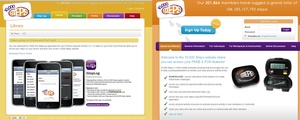iStepLog & 10,000 Steps

- Description:
10,000 Steps is an online/mobile physical activity promotion program that encourages you to use a step-counting pedometer to monitor your daily physical activity levels. After registering online you can access a ‘Step-Log' program which allows you to enter and track your steps (based on pedometer measurements or by converting activities to step-counts). You can then also download the iStepLog mobile app and sync it with your online program to track daily, weekly and monthly step totals and access various personal challenges. Additionally, the program is also designed for workplaces and communities and includes team-based challenges and resources for setting up community physical activity programs. Finally, the site offers peer support through online message boards that are available to registered users.
- Service URL:
- http://www.10000steps.org.au/
- Agency Responsible:
- CQ University Australia.
- Mobile Platform:
- Apple.
Details
- Format:
- Smartphone Application. Website program and accompanying mobile app
- Intervention Type:
- Educational (primarily educational material or psychoeducation). And self-monitoring
- Course Structure:
- No Set Course.
- Course Length:
- Short (less than 1 module or equivalent). The mobile app allows you to log your steps and can be used is conjunction with the wider online program
- Support Option:
- Automated only. The website also offers peer support
Target Audience
- Primary Category:
- Physical activity.
- Target Audience:
- Young Adult.
- Language:
- English.
Access
- Mobile platforms:
- Fee:
- Free.
- Access:
- Open: With registration. You need to register on the website to download the mobile app
- Contact Details:
through an online form: http://www.10000steps.org.au/help/contact-us/
Research evidence
- Research Trials:
- 2
- Research RCTs:
- 0
- Outcome Summary:
Initially, the 10,000 Steps website was developed as part of a wider health promotion campaign implemented in Rockhampton, Australia. The effectiveness of this wider campaign (of which the website was one element) was examined in one study - and produced positive results. A downward trend in physical activity observed over a 2 year period in a comparison community was not replicated in Rockhamptom where the 10,000 Steps intervention was implemented.
Moreover, a more recent study has examined the efficacy of the iStepLog app as an addition to the website. Activity levels and engagement with the intervention was examined among two groups of existing 10,000 Steps website members. One group was given access to both the website and the additional iStepLog app, while a second matched group was only given continued access to the website. Participants in the iStepLog group maintained their frequency of logging steps and level of physical activity over a 3 month period, whereas participants who only had access to the website showed a significant decline in the frequency and number of steps logged. Therefore, the iStepLog mobile app seems to add to the website's effectiveness.
- Recommended rating, reviewer 1:

- Recommended rating, reviewer 2:

Read more about Beacon's Smiley Rating System.
Research paper citations
Evaluation evidence studies:
Kirwan, M., Duncan, M.J., Vandelanotte, C. Mummery, W.K. (2012) Using Smartphone Technology to Monitor Physical Activity in the 10,000 Steps Program: A Matched Case-Control Trial. Journal of Medical Internet Research, 14(2): e55
Brown, W.J., Mummery, W. K., Eakin, E. & Schofield, G. (2006) 10,000 Steps Rockhampton: Evaluation of a Whole Community Approach to Improving Population Levels of Physical Activity. Journal of Physical Activity and Health, 1, 1-14.
Additional references:
Hinchliffe, A. & Mummery, W.K. (2008) Applying usability testing techniques to improve a health promotion website. Health Promotion Journal of Australia, 19 (1), 29-35.
Mummery, W.K. , Schofield, G., Hinchliffe, A., Joyner, K., Brown, W. (2006) Dissemination of a community-based physical activity project: The case of 10,000 steps. Journal of Science and Medicine in Sport, 9, 424-430.
User ratings
User ratings and comments are moderated in order to assure the quality of the submissions. It might take a week for your rating to show up.
Your rating
Login to rate this service.
Other user ratings
No ratings for this service yet.
Last Updated: October 22nd 2012

 Home
Home
 Categories
Categories Physical activity
Physical activity